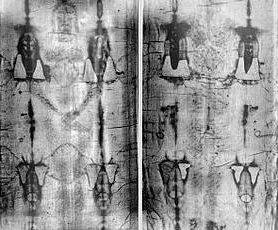|
|
||||
|
The Holy
Shroud
or
Shroud
of Turin is
a length of linen cloth
bearing the image of a man who is alleged to be Jesus
of Nazareth.
The cloth itself is believed by some to be the burial shroud he was
wrapped in when he was buried after crucifixion. The
shroud is kept in
the royal chapel of the Cathedral
of Saint John the Baptist in Turin,
northern Italy. The Catholic
Church has
neither formally endorsed nor rejected the shroud. The origins of the shroud and its images are the subject of intense debate among theologians, historians and researchers. Diverse arguments have been made in scientific and popular publications. Of interest is the fact that the oldest pictures of Jesus show him shaven with short hair. |
 |
|||
|
is given to the fact that the name “veronica” which by sheer coincidence means “the true image." |
||||
|
About the beginning of the 9th century, bones, teeth, hair,
garments, and other fictitious
relics of saints were conveniently "found" all over Europe
and Asia and triumphantly installed in the reliquaries of every
church. St. Luke was
touted as one of the ancient world's most prolific artists, to judge
from the numerous portraits of the Virgin Mary, painted by him, that
appeared in many churches. Some still remain, despite ample proof
that all such portraits were actually painted during the Middle
Ages.
By the 13th century, Constantinople was so crammed with relics that
one may speak of a veritable industry with its own factories. Among
these were letters in Jesus' own hand, the gold brought to the baby
Jesus by the wise men, the twelve baskets of bread collected after
the miraculous feeding of the 5000, the throne of David, the
trumpets of Jericho and the axe with which Noah made the Ark.
At one point, a number of churches all claimed to possess the one
foreskin of Jesus, and there were enough splinters of the "True
Cross" to build a synagogue.
The list of absurdities and frauds goes on, and, as Pope
Leo X was depicted as saying,
the
Christ story has been enormously profitable for the Church.
Most of these relics, including the Shroud, disappeared in the sack
of Constantinople in 1204 during the Fourth Crusade, and did not
surface again until the middle of the fourteenth century.,
it is evident that relic, and perhaps others, was confiscated by the
Knights Templar. Evidence is that it was worshipped by the Knights.
has found its way into the Templar mythos.
A 1287 account relates that it was kept in “a secret place to which
only the brothers of the Temple had access." It is further related
that it was “a long
linen cloth on which was impressed the figure of a man” and the
Knights were instructed to venerate the image by kissing its feet
three times.
Clement VII(1478-1534), one of several rival popes, after first
trying to hush up those who would expose the shroud of Turin, signed
papers declaring it a fraud. Supposedly, the artist who painted it
acknowledged it as a forgery. According to documents of that day,
certain men, for hire had pretended the "relic" cured them, giving
it a reputation, because the forgers desired to make money off it.
At that time Bishop Pierre D'Arcis excommunicated those who showed
it, but they were raking in so much money they found ways to get
around his decision.
The Dukes of Savoy guarded the lucrative object. In 1502 the current
Duke requested and obtained papal permission to build a chapel to
exhibit the "holy" relic. The Sainte Chapelle of the Holy Shroud was
officially completed on this day, June 11, 1502. With great fanfare
the Shroud was exhibited and then locked away. Pope Julius II
established a feast and mass for the shroud. Countless pilgrims
visited the site.
The shroud was reputed to have marvelous powers of protecting
people. It could not, however, protect itself, and on December 4,
1532, its chapel caught fire. Brave individuals rushed in to rescue
the cloth which had supposedly covered Christ in his burial. Before
they could reach it, silver had melted and scorched the cloth and
even burnt holes through it.
When the Dukes of Savoy transferred their headquarters to Turin, the
shroud went with them, and it is as the Shroud of Turin that it is
best known. A black marble chapel was built for it there.
The shroud was first photographed by Secondo Pia. He was astonished
when he beheld the negative from his camera. It had reversed the
negative image of the shroud and made it look lifelike. He claims he
nearly dropped the photograph. This led to claims that the work must
be an authentic negative image somehow made by the radiance of
Christ at his resurrection.
The scientific conclusion, which it must be emphasized is by no
means unanimous, is that the shroud is indeed a forgery, Most
conclusive of all were three carbon dating tests done by separate
laboratories which first carefully cleaned off the samples. The
church announced that the results placed the shroud's earliest
possible date at 1000 AD and most probable date between 1260 and
1390, the very time period in which the shroud had emerged into
human view. One of the arguments for the shroud's authenticity was
that pollens were found on it which originate only in the Middle
East. But the issue remains hotly contested and new arguments and
tests are constantly suggested by each side. |
||||